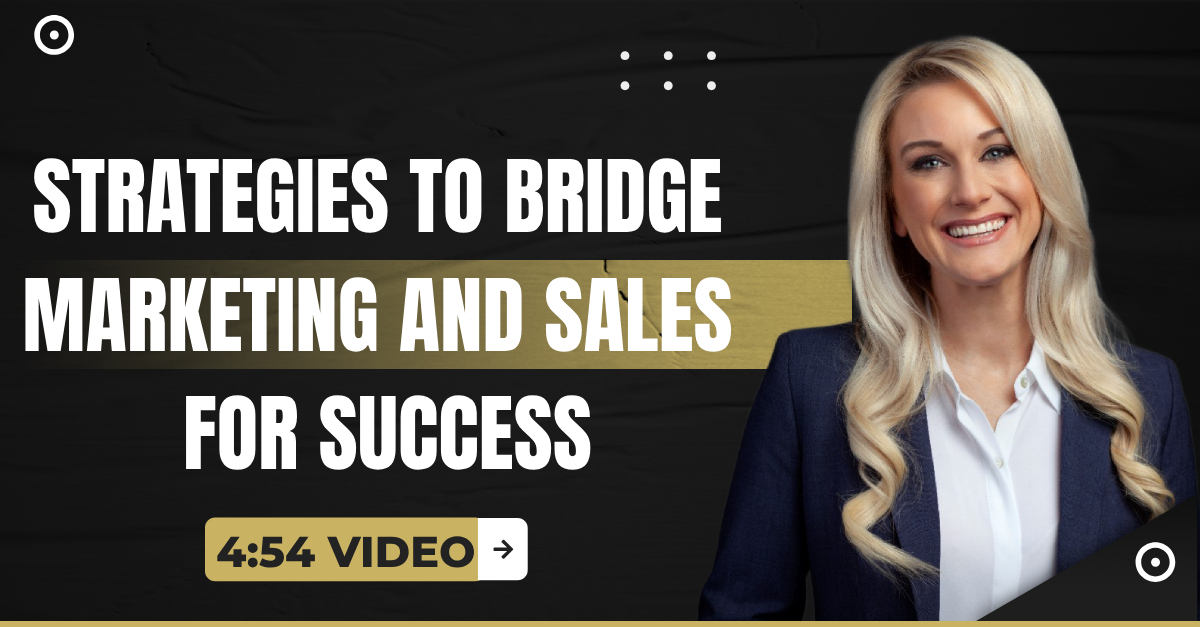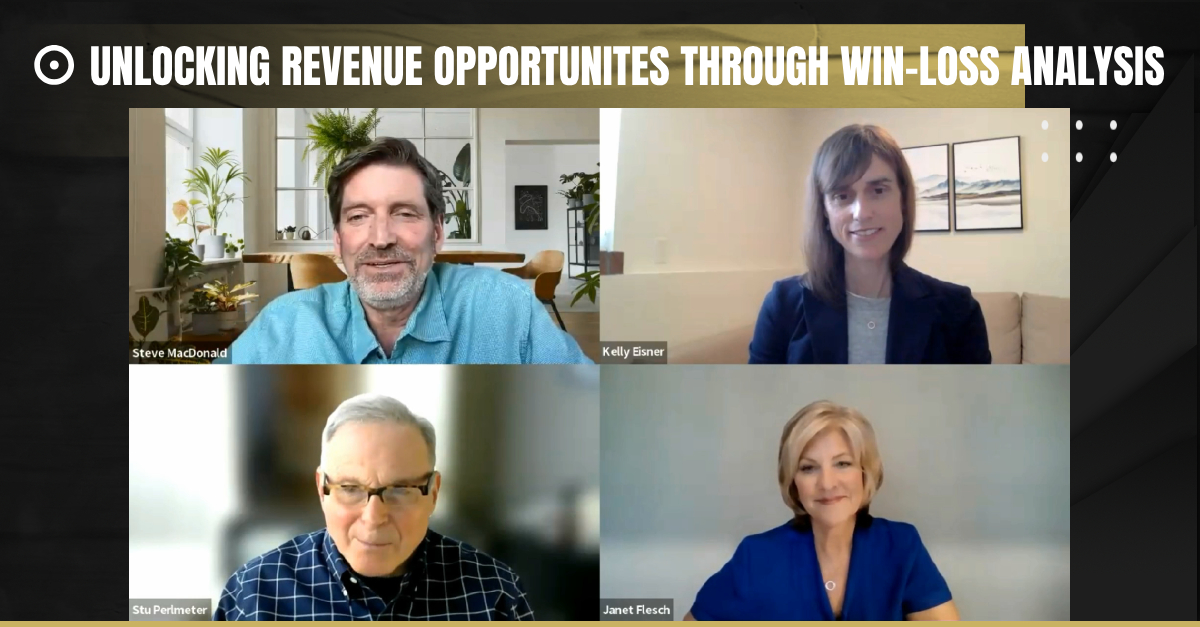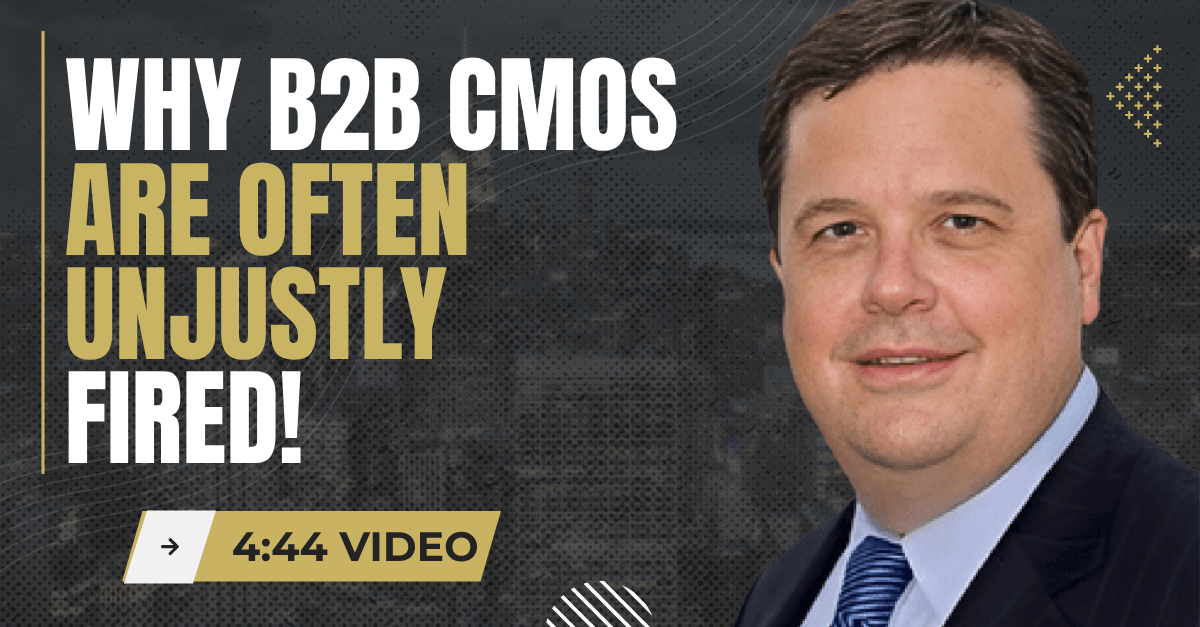Why B2B CMOs Fail So Quickly
Nine Modern CMO Strategies that Reverse the Trend

Content Marketing Is Complicated. For B2B sales, we simplify your path to being recognized as industry experts with the highest sales closing rates. As B2B founders, we know how to create content that positions your business as an authority, makes the case for your technology, confronts rational/emotional hurdles, and elevates your salespeople to trusted advisors—your competitive advantage in an ABM sales world. OUR PROMISE is to make your reputation a powerful and effective addition to your company’s core competencies.
The Challenges and Solutions
The average CMOs will be in their job for only 40 months, half as long as the average CEO. In fact, CMOs have the shortest C-Suite tenure of all C-suite roles. This can be attributed to a number of factors that we outline in this article, in addition to solutions where CMOs need to dive deep.
The role of the CMO in a B2B company is crucial, as it is responsible for driving revenue growth by developing cutting-edge marketing strategies that support sales. Yet a CMO’s unique challenges shouldn’t lead to shorter tenures and, thus, greater pressures from the start.
In this article, we will address the top challenges, along with solutions that align directly with the recommendations of Gartner about evolving the role of CMO to “Chief Customer Officer” as pivotal to the success of the company and B2B SaaS CMOs.
Gartner also states that B2B buying involves more emotions than most marketers assume.
- “Customers are making complex decisions that may put their job at risk, negatively impact their organization, or cause distrust with other stakeholders when it comes to allocating budgets in the future.”
The need for a much deeper understanding of the customer may be a major contributor as to why 38% of B2B organizations list “Differentiating our products/services from the competition’s” as a challenge to their marketing efforts.
Below are nine fundamental reasons why B2B SaaS CMOs struggle, all of which can be largely addressed with a deeper understanding of the B2B buyer, along with suggestions for solutions as the acting Chief Customer Officer.
1. The Rapid Pace of Innovation
The B2B industry is known for its rapid pace of change, with new technologies and products being developed and released at a breakneck speed. This creates high expectations for CMOs to constantly adapt to new trends, technologies, and customer needs. B2B companies often expect their CMOs to deliver results quickly and efficiently, which can put immense pressure on them to perform at a high level. The only way to thrive in this environment is to keep pace on an ongoing basis through the lens of the customer, understanding how this rapid pace of innovation impacts how they think and respond.

2. Delivering Results Quickly
Another challenge faced by B2B CMOs is the pressure to deliver results quickly. These companies are often venture-backed or publicly traded, with high expectations for growth. CMOs are tasked with generating leads, driving conversions, and ultimately increasing revenue, all while navigating a complex and rapidly evolving market landscape. This can be a daunting task, and those who are unable to deliver results may quickly find themselves replaced by someone who can.
Transformative CMOs are leading the discussion internally at or ahead of the pace of change from a customer-centric point of view, putting a deep understanding of the buyer at the forefront of keeping pace with delivering results.
3. A C+ Content Grade
Let’s start by saying that a C+ grade for content across the B2B industry might be too generous. Why?
- 96% of B2B buyers review thought leadership content before making a purchase, yet 71% of B2B decision-makers say “half or less than half of the thought-leadership content they read or watch gives them any sort of valuable insights.”
- 57 percent of sellers say they don’t pay much attention to content produced by their marketing teams, feeling it is generic and unresponsive. – McKinsey
- Sales reps don’t use 60 to 70% of marketing content. That means that about two-thirds of the investment in content development — often as much as 12% of the entire marketing budget – might simply be wasted.
- According to Forrester, an estimated 65% of content marketing assets that are produced go unused because they are irrelevant.
Poor content quality may be a leading factor for why 31% of salesperson’s time is spent searching for or creating their own content.
B2B SaaS companies cannot afford to provide C+ quality content or have their reps’ time spent creating it. If you want to garner the attention of your B2B buyers and improve alignment with sales, start by creating higher-quality content.
There is an opportunity for companies to level up their content and outpace the competition. – Forbes
The pandemic forever changed the B2B buying process, creating more reliance on digital content. This means that B2B SaaS companies must reconsider marketing and sales approaches in an environment much more reliant on digital information.
4. Emotionally Charged Thought Leadership Content

56% of final B2B purchasing decisions
are based on emotional factors.
B2B buying involves more emotional factors than most marketers are aware of, which is why most B2B companies don’t do what it takes to address these emotional purchase accelerators.
- According to Gartner, “Customers are making complex decisions that may put their job at risk, negatively impact their organization, or cause distrust with other stakeholders when it comes to allocating budgets in the future.”
- 95% of decision-makers state that, even before contacting a supplier, feeling a sense of connection to a supplier’s brand is as important as feeling confident about what they do.
Brand affinity is most important at the very beginning and at the very end of the buyer journey. It is critical for suppliers to have a strong brand in which customers feel emotionally invested.
Sure, companies need to satisfy customers’ rational needs and wants – having the right product at the right price – in order to enter the consideration set but in the race between silver and gold, emotion prevails. – The State of B2B Survey: Winning with Emotion
Four key emotions dominate when influencing purchase behavior:
- Trust in the supplier’s credibility
- Confidence in the supplier’s ability to deliver
- Optimism about what they could do for the buyer’s organization
- Pride in the prospect of partnering with the supplier
Addressing these four emotions alone increases the chances of the supplier winning the business by 50%.
The supplier which establishes a thought leadership position is the supplier which carries favor with potential buyers. Business decision-makers reported that a demonstration of expertise via content marketing was the third-most important factor in evaluating suppliers under consideration. For enterprise decision-makers, thought leadership was even more influential (ranking as the second-most important factor).
To get ahead of the competition early on, CMOs need to fully embrace the need for thought-leadership expertise represented through content marketing. Thought leadership paves the way to communicating a differentiated value proposition that allows your brand to stand out from the crowd.
Forbes adds one more dimension to the importance of thought leadership content, saying, “Content Marketing solves problems while thought leadership sparks conversations.”
5. The SaaS Advantages that Fuel Digital Transformation
It’s time to project at a whole new level how important your SaaS company is to your clients and prospects.
- The Harvard Business Review is touting SaaS as the acceleration for digital transformation.
- Deloitte states, “Digital transformation is the essential bridge between the business of today and the business of tomorrow.”
- Deloitte also mentions that “Moving to SaaS allows for continuous updates with less complexity–all in a secure environment that fuels agility, insight, and innovation.”
Here is the main question to ask yourself as a SaaS executive:
If the world’s largest consulting firms think this highly of SaaS, do you? And do your sales and marketing strategies reflect it?
In a recent strategic insights interview that I conducted with a partner at one of the world’s top 5 consulting firms on behalf of a client, the partner characterized a recent working relationship with a SaaS company this way: “It would have made it very difficult for our team to deliver without them. There would have been a lot more pain, a lot more blood, sweat, and tears.”
A major media publisher said this about the relationship with their ad management SaaS partner, “From my perspective, we really couldn’t grow the company without them.”
In our role as SaaS executives, we need to strive to seriously enhance the role that the industries, companies, departments, or individuals whom we represent play. The digital transformation you make needs to be positioned in a way that matches the impact that you create.
SaaS = RAMP (Revenue Acceleration Management Platform): B2B SaaS companies should be positioning themselves in terms of being revenue acceleration enablers. When it comes down to it, SaaS companies provide the visibility to get eyes on elusive, siloed data that maximizes automation, insights, and profits. From identifying key metrics for growth to discovering gaps and new opportunities, real-time, accessible data allows teams to skip the guesswork, collaborate across functions, and focus on the few things that will have the most impact on the business overall.
What can you do to add value from the vast amount of data that runs through your SaaS company? Your clients only have access to their own data, but you have the ability to add valuable insights on a much broader basis.
A recent survey showed that 39% of B2B Marketers said “using unique data and insights” was particularly powerful in attracting new audiences. Just think if all B2B marketers had the treasure chest of data that we have as B2B SaaS companies.
The more that B2B SaaS companies can connect the dots beyond the more generic promises of growth, efficiencies, collaboration, or automation and focus on their core business model of a buyer organization’s processes, problems, and decision points, the better.
Start elevating your importance to B2B buyers by framing your SaaS at the heart of the digital transformation that will take them into the business of tomorrow. Use your content marketing strategy as the full-funnel face of your company, from thought leadership to core solution offerings.
6. Inability to Differentiate the Product
Another common reason why B2B CMOs fail is that they need to differentiate their product from the competition. With so many solutions available on the market, it can be challenging to stand out from the crowd. Successful CMOs find ways to go beyond simply highlighting the unique benefits of their product and demonstrate a broader distinction from the competition.
Forbes summed it up well in their article “Why Differentiating Data Is Key For B2B Marketers.” The talk about focusing on first-party data, “The information that comes directly from a company’s customers—gives B2B marketers the ability to differentiate themselves from their competitors. This dataset encompasses a wide range of information, spanning from customers’ buying patterns to their online browsing habits. Through the analysis of this personalized data, marketers can effectively promote their products by precisely identifying their audience’s preferences and showcasing them in their advertising campaigns.
This first takes a well-researched understanding of the problems, risks, and opportunities within your B2B buying audience that can be directly addressed with a data-driven, customer-centric advisory sales approach.
7. Internal Alignment
B2B CMOs also face challenges related to internal alignment and stakeholder management. These companies often have multiple stakeholders, including sales, product, and executive leadership, each with their own priorities and agendas. CMOs must be able to navigate these competing interests and build consensus around marketing strategies and priorities. This requires strong communication skills, political savvy, and building relationships across the organization. Those unable to build consensus or manage stakeholders effectively may find themselves on the outs with key decision-makers.
In an environment with multiple stakeholders who all have their own opinions, there is only one voice that will win out consistently—the voice of the customer. If you want to be the marketing leader that truly leads the internal conversations, you need to represent the most up-to-date voice of the customer.
8. The Chief Customer Officer Solution
CMOs need to have an evergreen, relentless strategy of understanding the changing needs of the customers, new technologies, and overall industry trends. But unless this translates into overall content marketing strategies, promotions, events, and sales enablement, the opportunity will be wasted.
CMOs need to think about how a “Chief Customer Officer” focus not only empowers traditional marketing strategies but enables sales to become the leading voice to buyers as consultants or trusted advisors, achieving a major competitive advantage over the competition.
Think like a Chief Customer Officer
- Forbes: A LinkedIn survey found that B2B buyers are five times more likely to engage with a sales professional who offers new insights into their business.
- Harvard Business Review: B2B buyers don’t trust or respect salespeople. Just 18% of the salespeople buyers met over the past year would be classified as trusted advisors they respect.
- SalesForce: 78% of business buyers seek salespeople that act as trusted advisors with knowledge of their needs and industry.
- LinkedIn: Roughly one-third of B2B customers don’t trust salespeople and are reluctant to buy from them. 88% buy only when they see a salesperson as a “trusted advisor.”
Hank Barnes of Gartner explains, “Buyers have access to all this stuff from vendors, but making sense of it, interpreting it, understanding that they have the right stuff is where they’re really struggling.”
9. The Solution for Sales Enablement
Create TRaaS (Trusted Advisors as a Service) within your B2B company. What would sales need in order to be perceived as trusted advisors on a regular basis? Right now, salespeople are spending a third of their time in research and content development in order to be perceived as that trusted advisor. But that’s not what any salesperson has ever been hired to do.
There needs to be a plan and process that is responsible for continually collecting and distilling deep industry/buyer insights and trends that are coupled with your own SaaS data and continually delivered for sales to use.
Conclusion
B2B CMOs have the shortest C-suite tenure for various reasons, including the rapid pace of innovation and disruption, pressure to deliver results quickly, challenges related to internal alignment and stakeholder management, the inability to consistently deliver high quality thought leadership content and differentiating their products. Those who are able to navigate these challenges successfully can thrive in this exciting and dynamic industry. At the same time, those who are unable to keep up may find themselves out of a job sooner rather than later.
First, as the CMO, you need to take on the role of the voice of the highest authority within the company, the voice of the buyer.
Second, you need to change the game on how you are being judged—not by the volume of MQLs, as less than 1% of leads in B2B ever become customers. B2B Sales is a long game, and expectations need to be created internally that setting up the company, the CEO, and the sales staff as trusted industry experts is job one. With that will come leads that trust the company and the people—and will convert at higher levels.
Third, the ascent of thought leadership content should tower above most all priorities as an innovative approach to distinguish the company from competitors, spark high-level conversations, and drive an increase in sales closures.
Finally, 70 percent of marketing’s time and efforts are spent on tactical work, and only about 30 percent is spent on strategic activities. This model needs to be flipped upside down.
Your company was founded with a mission to make it simple to grow faster using data. What exactly does that mean? How can you help your customers to solve their problems by using data to grow faster? You need to be intimate with customers, for starters, to achieve a true partnership (versus data vendors) with all the benefits.
To learn more about how leading CMOs are transforming their content and sales enablement strategies, please CLICK HERE to schedule a 20-minute strategy session.






